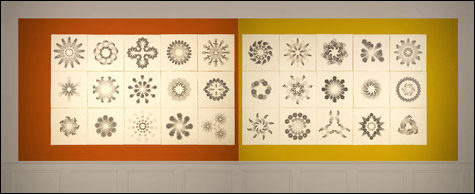
KALEIDOSCOPING Ott’s diamond froth #3. |
In 2004, AS220's StinkTank put out a paper titled "Compost and the Arts." It's probably the most concise and astute thinking on how to foster creative communities that I've ever read. Its key idea: create creative crossroads — places where people cross paths to show art, perform, hang out, display announcements, make art. The idea is that places where people share work, ideas, and techniques — places, not coincidentally, like AS220 — inspire people to keep making art, encourage artists to learn from each other, challenge them to make better art, and to keep making it here.
"Compost and the Arts" articulated how to lay the foundation of creative communities. Now "NetWorks 2008" — a group of photos, exhibits, and videos — is a proposition about how to keep a creative community going. "It is my assertion that the more conscious we are about documenting Rhode Island's community of makers," AS220 artistic director Bert Crenca writes in the catalogue, "the more likely that this community will be sustained and, in fact, grow."

"NetWorks 2008" is the brainchild of Crenca and Joseph Chazan, a Providence doctor and art collector, who is the project's sugardaddy. Originally they planned to just document Rhode Island artists. But the project grew into three exhibits: AS220's Project Space (93 Mathewson Street, Providence, through December 28) offers photo and video portraits of the artists; the Newport Art Museum (76 Bellevue Avenue, Newport, through January 19) presents the artists' work; and 5 Traverse gallery (5 Traverse Street, Providence, through December 24) offers what mostly feels like leftovers from Newport, but this time for sale.
At Newport, highlights include Toots Zynsky's ravishing red glass-thread bowl, which curls open like a flower, and Jacqueline Ott's kaleidoscoping patterns of penciled pinwheel shapes, which seem to hover out from the paper because of the way she carefully shifts the tone of her marks. C.W. Roelle wows with how'd-he-do-that "drawings" in twisted black wire. His tour de force is an ornate six-foot-tall portrait of pair of seated ladies in long flowing dresses with a couple dancing behind them.
Xander Marro's style seems a blend of girly Victorian dreaming, Monty Python cartoons, Russian onion domes, beehive hairdos, Pee-wee's Playhouse, Barbarella, and Dr. Seuss. At Newport, she presents The Other Victorians, an antique-looking crazy quilt populated by alluringly odd creatures — a diamond with six lady legs, a person with a cuckoo clock head, a hand with switchblade fingers. These characters reappear at 5 Traverse, cavorting in Marro's awesome psychedelic sci-fi girly puppet stage with a patchwork backdrop and red shag floor. Someone needs to put together a big local solo show of her stuff. Now.
"NetWorks" also features Howard Ben Tre's icy green Zen glass sculptures, Crenca's wacky surrealist paintings, Ruth Dealy's expressionist paintings, Lucas Foglia and Scott Lapham's deadpan photos, Mark Freedman's gray industrial landscapes, Salvatore Mancini's romantic photos of Native American petroglyphs, Timothy Philbrick's eminently tasteful furniture, Denny Moers's visionary photos, James Watkins's still lifes in chunky glass, Elizabeth Pannell's brushy landscapes, and Walter Feldman's totem and pictograph painting. Angel Quinonez's bright paintings riff on pop culture and art history — Joe Louis, Frida Kahlo, the Elephant Man, Van Gogh's trademark sunflowers stuck into a can of Goya green pigeon peas. Jonathan Bonner offers fine line drawings that look like intestines or sperm, plus a copper pipe sculpture that resembles a 12-foot horn folded in half.
Organizers carefully don't call these 19 folks the state's "best" artists — they favor "accomplished" or "premiere" instead — but at its core, it's a hall of fame show. (Let the backlash begin.) They are by and large artists Chazan has collected and/or affiliated with AS220. It skews toward well-established artists, whose work I tend to respect more than I enjoy. And it's not the most flattering or informative presentation of each artist's work. (This is a difficult show to pull off — lots of artists, just a small sample of each.)
However, the videos, which may be the most lasting part of the project, do a good job of showcasing the art and artists. (To see them, get a catalogue or search YouTube for "NetWorks" and "AS220.") There are artists I'd add or drop, but the group does feel like a representative sample of Rhode Island art. If you're trying to build an archive of contemporary local art, "NetWorks" ain't a bad way to start.
Read Greg Cook's blog at gregcookland.com/journal.